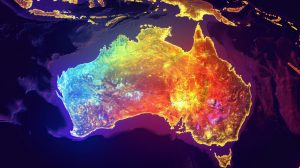Increasingly economic policy conditions are being made with national security considerations. The rise of China as a globally economically integrated superpower has created conditions distinct from the previous major Western ideological rivalry with the Soviet Union, where trade was minimal. Yet China’s willingness to use economic carrots and sticks – as well as the supply chain difficulties created by the COVID-19 pandemic – is leading to a rethink about how countries like Australia can both ensure domestic economic resilience, and advance key strategic industries through market intervention.
Australia’s comparative advantage has always been its abundance of natural resources – a massive continent filled with seemingly endless deposits of a variety of ores, as well as a bounty of coal and gas. However, due to this the country has suffered from its own unique resource curse. It has become so prosperous from simply digging things up and shipping them overseas that it hasn’t felt the need to do much else. This has given the country an odd economic profile, more akin to a Central Asian petrostate than countries it shares income levels and development status with.
The country’s lack of economic complexity has also presented Australia with a dilemma – what if its current cash cows come under threat, either through the economic statecraft of other countries, or through technological change? This is the problem Australia currently faces with the green energy transition. Although its resource exports are holding for now, the expectation is that eventually – when technology and price-points make green energy irresistible – these exports will fall off a cliff. And then what will Australia have to replace them as a source of income?
The Future Made in Australia initiative seeks to address this. The thinking is that rather than a threat, the green energy transition can be an opportunity for Australia. While the country has a wealth of critical mineral deposits used in the manufacture of renewables technology, it also has an abundance of sunshine and wind, and the undeveloped or uninhabitable landmass to generate such renewables at a massive scale.
However, rather than just mining of raw materials and generation of power, the Australian government has understood the energy transition as an opportunity to create something it currently lacks, and that a country of its wealth and education should have: a significant high-tech manufacturing capability. The supply of these technologies is currently highly concentrated, with China dominating the markets for solar panels and lithium-ion batteries. This creates a vulnerability to Beijing’s whims as the demand for these technologies heightens.
Initially announced as part of the government’s May budget – and being debated in Parliament this week – the Future Made in Australia initiative will invest US$15 billion in areas of strategic significance. The plan is to establish a national interest framework, which would assess what the government should invest in. These investments would be based around two core streams. The “Net Zero Transformation Stream” will focus on areas where Australia can have a competitive advantage in green-tech related industries. These include battery and solar panel manufacturing, green hydrogen production, and the processing of critical minerals. Alongside this will be an “Economic Resilience and Security Stream,” focused on vital domestic capabilities that the private sector may not necessarily invest in itself.
Modern economic statecraft is less about a return to the protectionism of the past – at least for those other than Donald Trump – and more about strategic investments in key sectors deemed essential for future growth. This form of statecraft seeks to be at the forefront of technological change, rather than seeking to prevent it. This “domestically-oriented economic statecraft” involves promoting policies and creation incentives that aim to strengthen specific domestic industries for geostrategic purposes.
A recent paper from Asia-Pacific Development, Diplomacy and Defense Dialogue (AP4D) looks at how to strike the balance between allowing the market to function freely without undue government interference and recognizing which sectors require incentives in the national interest. Governments aren’t normally great at picking economic winners, while the private sector may not fully grasp Australia’s geostrategic interests. It is vital that open information is shared between the two, so the government understands market opportunities and the private sector is aware of what government policy is seeking to achieve.
As a country currently reliant on industries that have a clear shelf-life, the Australian government has a keen motivation to incentivize the emergence of new industries that will protect its standards of living and advance its strategic position. But beyond this, Australia is currently underutilizing its highly educated population, with a lack of opportunity to work on or advance key technologies. It is clearly in both Australian domestic and geostrategic interests to shift the country out of its current economic profile.

































